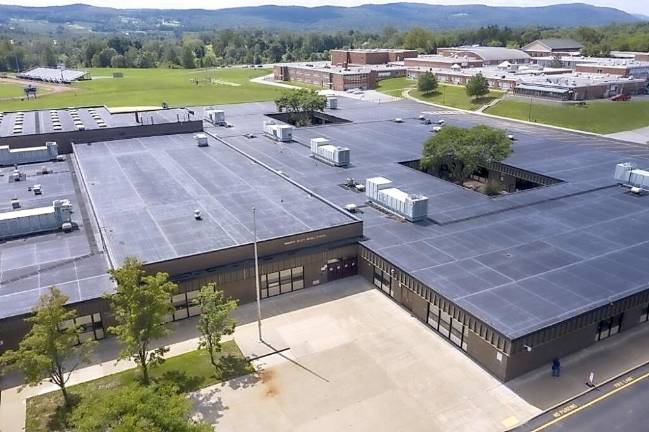School budget season begins
Warwick. The district superintendent laid out the upcoming challenges ahead to continue providing sound educational programs without unduly burdening taxpayers.

While repeatedly emphasizing “these high inflationary times,” Warwick Valley Central School District Superintendent Dr. David Leach laid out in broad strokes the challenges the district may face in balancing its need to continue providing sound educational programs without unduly burdening district taxpayers as the annual budget process begins.
Leach’s remarks at the Feb. 2 Board of Education meeting, preparing residents for a possible gap between likely New York State aid and actual operating costs for the school district.
He noted that the two largest funding sources are the school tax levy (accounting for 63%) and state aid (making up some 30%) with other funding sources rounding out the balance.
New York aid
There are two types of state aid are formula-driven, which typically covers items like textbooks, hardware and software, and high taxes; and expense-driven, which is used for transportation, BOCES, building, and public and private excess cost.
“We anticipate about $4.4 million in NY State aid,” Leach said.
School board member Bob Howe noted that the state legislature traditionally “gives more than the governor does.” Leach counseled Howe not to depend on that.
“This year, foundation aid looks more promising than most,” Leach said, adding that foundation aid may be fully funded this year for the first time.
Wealth vs. aid
As Warwick is a more affluent community with the highest composite measure of a household’s cumulative living standard - or wealth index - in the region, its school district typically receives less aid than other comparably-sized districts. For example, Minisink Valley received $28,457,088 and Valley Central received $32,666,367 in foundation aid for the current school year while Warwick received $18,977,656.
Warwick’s combined wealth ratio, standing at 0.97, also puts it above neighboring districts, like Middletown (0.447), Newburgh (0.473), Minisink (0.634), or Monroe (0.778).
Gov. Kathy Hochul’s state aid run (the first pass through before it goes to the Legislature for the lawmakers’ markups and inevitable changes) for the 2023-24 fiscal year/school year is more than $37M – an increase of more than $5M over the current year’s budget.
While categories like foundation and BOCES aid show an increase, transportation, building aid, and public and private excess cost have been reduced since last year.
Universal Pre-K
Funding for Universal Pre-K will rise to $1,036,800, an increase of $523,800.
Leach said that interested parents of preschoolers might not need to enter a lottery this year, because there are enough seats.
Board member Bill Fanos said that “We’re being hooked into” Universal Pre-K by “the good graces of Albany,” and that the “main driver of UPK is the lower-income demographic in New York City.”
Leach said he would’ve preferred that the program be “driven by other criteria,” such as being needs-based.
Cost drivers
Among the greatest expenses in the budget, according to Leach are “Human capital,” which includes teachers and staff, as well as their health insurance. Family plan premiums have increased in cost every year, except for the 2021-22 school year. The administration projects health insurance to cost $13,697,039 in the current budget.
Some of the places where the board may find cost savings include cooperative purchasing with other districts; contract renegotiations with staff unions; using staff for school improvements; improved energy efficiencies (at no additional costs to taxpayers); renting out space at the former Kings and Pine Island elementary schools; solar projects and increasing part-time work in order to save on benefits, among other measures.
Long-range planning study
The overall student population for the next decade in the district is “pretty stable,” Leach said, with around 3,700 students on average - so there’s no need for either opening or closing another school building.
He added that the numbers show a projected student peak to come in 2025 for K-4 with 1,341 students; in 2029 for grades 5-8, at 1,223 students; and in 2032 at the high school, with 1,424 students projected.
Individual class sizes, he said, tend to be between 20 to 24 students on average.
In terms of ethnic/racial makeup, there has been “a shift” he said. Between 2010 and 2020, the white segment of the population decreased from 82% to 78%, while the Hispanic/Latino portion of the population increased from about 9.4% to nearly 12.5%.
Also, according to the study, Black, Asian, and multi-racial individuals composed less than 4% of the resident population in 2020.
The district will send out its legal ads on March 29 and April 12 and the board will adopt the proposed budget on April 20. The budget hearing is set for May 4 while school board elections and the budget vote are on May 16.
On Feb. 16, 2023, the school board work session will have budget presentations 3 & 4 with projected revenues and payroll benefits. The meeting will be held at the Dorothy C. Wilson Education Center at 7 p.m.